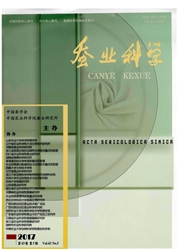

 中文摘要:
中文摘要:
杂种优势的表达机制是杂种优势利用的理论基础。以家蚕品种“芙蓉”和“菁松”为中系亲本,以“湘晖”和“872”为日系亲本,分别进行杂交并连续同蛾区交配和定向选择,获得了优良中系“芙菁”(D)和茧丝量性状有显著差异的2个日系家系“湘8A”(A)和“湘8C”(C)。F4代“A”、“C”与“D”的遗传距离差异较小;F6代“A”与“D”的遗传距离比“C”与“D”的遗传距离大。F4代用“D”分别与“A”和“C”组配杂交种的各项性状差异不明显;F8代则各项性状有明显的差异,且(D×A)F,表现出更好的生产性能优势;F4代、F8代以及(D×C)F,的杂种优势均大于(D×A)F1的杂种优势,但(D×A)F1的实际生产性能比(D×C)F1好。研究结果表明,采用DNA多态性遗传距离为依据纽配的杂交组合,能够获得丰产性能更好的优良一代杂交组合。
 英文摘要:
英文摘要:
The expression mechanism of heterosis is rationale to utilize heterosis. Through hybridizing silkworm varieties, "Furong" and "Jingsong", and directly selecting the offspring, we obtain the excellent Chinese system "Fujing" (D). In the same way, hybridizing "Xianghui" and "872", we get two Japanese systems, "Xiang8A" (A) and "Xiang8C" (C), which silk quality is obviously different, in F4 generation, the genetic distance between "A" and "D" has no significant difference with that of between "C" and "D". But in F6 generation, the former is longer than that of the later. In F4 generation, the diversity of economic characters between hybrids (D×C) and (D×A) is not obvious. But in Fs generation, it shows notably, and hybrid (D×A) is better in producibility. In F4 and F8 generation, the heterosis of hybrid (D ×C) is more than that of hybrid (D×A), while the later shows better comprehensive character. The above results indicated that hybridation combination, which selected based on the genetic distance of DNA polymorphism, can produce the excellent hybrid.
 同期刊论文项目
同期刊论文项目
 同项目期刊论文
同项目期刊论文
 期刊信息
期刊信息
